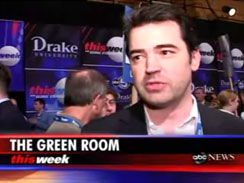I just listened an interview that Mark Ramsey did with a couple of guys from the San Diego Union-Tribune (runs 17 min). Twenty minutes ago I’d have described Ron James and Marc Balanky as newspapers guys. Now, I’ll call them media guys.
And they’re gearing up to do what we used to call radio (and, eventually, TV). A couple of things they said jumped out at me:
"We have a newsroom that works 24 hours a day" and "…we have more than 300 reporters."
I flashed on all the empty or near-empty radio newsrooms out there. These guys are serious as a heart attack and I’d be damned worried if I were "just" a radio station in that market. On the other hand, if you aren’t already well down the road to being more than just a radio station, don’t sweat it. Squeeze what you can from old Bossie and remember the good times.

 I rely on sites like engadget and gizmodo to live blog events like Wednesday’s big product launch of the new iPods. And I’m always amazed that anyone can listen/think/type that quickly.
I rely on sites like engadget and gizmodo to live blog events like Wednesday’s big product launch of the new iPods. And I’m always amazed that anyone can listen/think/type that quickly. This post at E-Meida Tidbits is aimed at journalists who worry about the additional time it takes to blog. But I think this is good advice for any blogger.
This post at E-Meida Tidbits is aimed at journalists who worry about the additional time it takes to blog. But I think this is good advice for any blogger. Kay Henderson was back in the digital Green Room following ABC News’ debate this morning in Des Moines. The “other guys” in the headline were: Actor Ron Livingston; the LA Times’ Mark Barabak; ABC News Political Director David Chalian and ABC News senior political reporter and author of “The Note” Rick Klein.”
Kay Henderson was back in the digital Green Room following ABC News’ debate this morning in Des Moines. The “other guys” in the headline were: Actor Ron Livingston; the LA Times’ Mark Barabak; ABC News Political Director David Chalian and ABC News senior political reporter and author of “The Note” Rick Klein.”